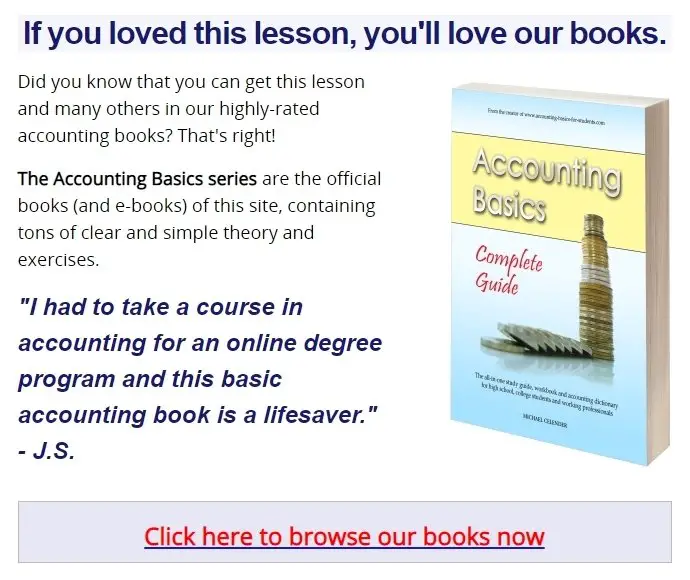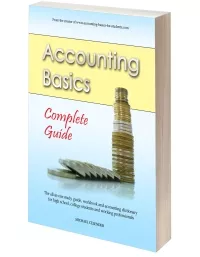Basic Accounting Transactions
Lesson One: Basic Accounting Transactions (this page)
Lesson Two: Owners Equity Example
Lesson Three: Accounting Equation: Liability Examples
Lesson Four: Asset Purchase Example
Lesson Five: Drawings Example
Lesson Six: What is Profit and Loss?
Lesson Seven: Income: Definition and Examples
Lesson Eight: Accrued Income - part 1 (income that is still owing to you)
Lesson Nine: Accrued Income - part 2 (getting paid by someone who owes you)
Lesson Ten: Expenses: Definition and Examples
Lessons Eleven & Twelve: Accounts Payable: Definition and Examples
Check out the quiz on this lesson in the Test Yourself! section further below when you're done. And right at the bottom of the page, more questions on the topic submitted by fellow students.
Do you know that there are only about 10 individual basic accounting transactions?
In this section we're going to cover each of these transaction types.
But before I get into specific examples of each one, let's make sure we understand what we're dealing with.
What is a Transaction?
So, what exactly is a transaction?
A transaction can be defined as an exchange of goods or services between two parties.
Each transaction represents some sort of change to one's assets, liabilities or owner's equity.
In other words, a change to the financial position of the business.
An accountant or bookkeeper has to record each transaction. This ensures that good records are kept and financial reports are produced which accurately represent the business.
The Ten Most Common Basic Accounting Transactions
Here is a quick summary of the ten common basic accounting transactions, together with a link to the full lesson on each one.
Please note that the lessons in the links below are basic introductory lessons which show how each transaction affects the accounting equation, and that these do not yet cover double entries (debits and credits).
See the chapter on double-entry accounting for a deeper look at each of these transactions (including the debit and credit entry for each one).
1. The Owner Investing Capital
Capital is the investment of assets by an owner into a business.
So this is a transaction where the owner puts money or something else valuable into a business.
Click here for the full lesson on this owner's equity transaction.
2. Creating a Liability (Debt)
In this transaction a business incurs a debt (a debt is created or owed).
For example, the business receives a loan from the bank.
Click here for the full lesson on a liability transaction.
3. Purchasing an Asset
This transaction involves a business spending money to acquire an asset (something of value).
Click here for the full lesson on buying an asset.
4. The Owner Withdrawing Business Funds
This is the opposite of the first transaction above (capital) - the owner withdraws funds from the business (divests).
Withdrawing funds from a business is known formally as drawings.
Click here for the full lesson on drawings.
5. Income Received Immediately
In this transaction the business makes money from income and the money is received immediately (at the time the services are provided or the sale is made).
Click here for the full lesson on income received in cash.
6. Income on Credit
As opposed to the previous transaction, in this one the cash is not received right away, but instead is owed to the business.
Click here for the full lesson on income made on credit.
7. Getting Paid by a Debtor
A debtor is a person who owes money to our business.
When a debtor pays us for the debt owed, we have to record this payment and cancel out the records of that debt.
Click here for the full lesson on receiving a payment from a debtor.
8. Expenses Paid Immediately
In this type of transaction we have an expense and pay this immediately.
Click here for the full lesson on cash expenses.
9. Expenses Owing (Accounts Payable)
This is the same as just above except that one doesn't pay the expense straight away, but instead owes it. This is recorded differently to an immediate payment.
Click here for the full lesson on accounts payable.
10. Paying a Liability
In this final type of transaction we pay off a debt that we owe.
Click here for the full lesson on paying a creditor.
And click here for the example of repaying a loan.
Test Yourself!
Before you start, I would recommend to time yourself to make sure that you not only get the questions right but are completing them at the right speed.
Difficulty Rating:
Beginner
Quiz length:
2 questions
Time limit:
3 minutes
Important: The solution sheet on the following page only shows the solutions and not whether you got each of the questions right or wrong. So before you start, get yourself a piece of paper and a pen to write down your answers. Once you're done with the quiz and writing down your answers, click the Check Your Answers button at the bottom and you'll be taken to our page of solutions.
Good luck!
That's it!
The list above represents all the basic accounting transactions we have.
Once you understand how they work, you'll be well on your way to becoming a star in accounting.
When you're done with these lessons, move on to the next chapter, where we'll go deeper into these transactions and cover the double entries we have to make for each one.
Return from Basic Accounting Transactions to the Home Page
Stay up to date with ABfS!
Follow us on Facebook:
Lesson One: Basic Accounting Transactions (this page)
Lesson Two: Owners Equity Example
Lesson Three: Accounting Equation: Liability Examples
Lesson Four: Asset Purchase Example
Lesson Five: Drawings Example
Lesson Six: What is Profit and Loss?
Lesson Seven: Income: Definition and Examples
Lesson Eight: Accrued Income - part 1 (income that is still owing to you)
Lesson Nine: Accrued Income - part 2 (getting paid by someone who owes you)
Lesson Ten: Expenses: Definition and Examples
Lessons Eleven & Twelve: Accounts Payable: Definition and Examples
Questions Relating to This Lesson
Click below to see questions and exercises on this same topic from other visitors to this page... (if there is no published solution to the question/exercise, then try and solve it yourself)
Name the Accounts Exercise
(Plus Journals)
Before you begin: For purposes of exams and testing it's important to make sure you not only answer accounting questions correctly but can complete …
Which Accounts are Affected by these Transactions?
Q: Which accounts are affected in each of the following transactions?
April 3 Purchased office supplies on account, $300.
April 4 Received prepayment …
Double Entry Exercise:
Which Accounts Are Affected?
Before you begin: For purposes of testing and exams it's important to make sure you not only get the questions right but are completing them at the …
Journal Exercise
1/04/1991 XYZ started business - capital of shilling 16000
2/04 purchase machinery of sh.7000.
3/04 bought future from sh.300.
7 " purchased goods …
© Copyright 2009-2023 Michael Celender. All Rights Reserved.
Click here for Privacy Policy.






Comments
Have your say about what you just read! Leave me a comment in the box below.